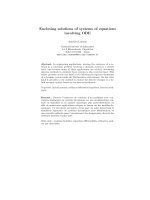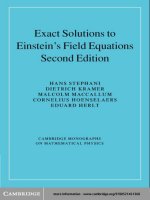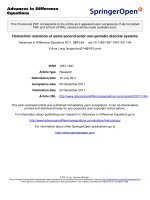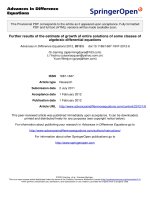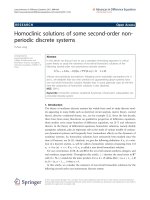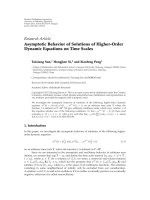Enclosing solutions of systems of equations
Bạn đang xem bản rút gọn của tài liệu. Xem và tải ngay bản đầy đủ của tài liệu tại đây (677.42 KB, 22 trang )
Enclosing solutions of systems of equations
involving ODE
Aurelien Lejeune
National Institute of Informatics
2-1-2 Hitotsubashi, Chyoda-ku
Tokyo 101-8430 – Japan
Abstract. In engineering applications, proving the existence of a so-
lution in a constraint problem involving a dynamic system is a central
issue, and because many of these applications are critical, developing
rigorous methods to simulate those systems is also a central issue. This
rep ort presents on the one hand a tool allowing the rigorous simulation
of a dynamic system inside the Mathematica environment. On the other
hand it provides a new method to enclose the discrete changes in a hy-
brid dynamic system based on the interval arithmetic.
Keywords: hybrid systems, ordinary differential equations, interval arith-
metic.
Resum´e : Prouver l’existence de solutions d’un probl`eme sous con-
traintes impliquant un syst`eme dynamique est une probl´ematique cen-
trale en ing´eni´erie et en analyse num´erique plus particuli`erement, en
effet de nombreuses applications critiques se basent sur des mod`eles dy-
namiques. Ce document presentera d’une part un outil permettant la
simulation rigoureuse de syst`emes dynamiques pour Mathematica, et
une nouvelle m´ethode pour l’encadrement des changements discrets des
syst`emes hybrides d’autre part.
Mots-clefs : syst`emes hybrides, ´equations differentielles ordinaires, anal-
yse par intervalles.
1 Introduction
Over the last few years, interval arithmetic was developed to provide a rigorous
enclosure of the solution of a numerical system. It is especially interesting for
engineering in critical systems where the enclosure of a solution is more impor-
tant than obtaining quickly an approximation. One of the limitations when using
interval arithmetic is that an initial box, where the solution is supposed to be,
is needed.
This document is divided into two main parts, in the first one we present
a plug-in to manipulate and solve rigorously an ODE involving intervals. This
plug-in is written to be used under the Mathematica environment. This plug-in
is based on a famous ODE solver library, VNODE. The plug-in is also written
to be user friendly for someone accustomed to using Mathematica. We describe
briefly its implementation, then we present some examples of applications.
In the second part we present a new method for solving systems involving
ordinary differential equations which does not need this initial box. The aim of
the method is to determine if there exists a solution in the neighbourhood of an
initial approximate solution and to rigorously compute its enclosure.
1.1 Preliminaries
Notations Vectors are denoted by boldface symbols, matrices by capital letters.
Interval vectors and matrices by bracketed symbols.
Results notations The interval values in the result are denoted with two
notation. A classical notation (e.g. [1.845878548, 2.88745783]) and a shorter no-
tation for interval with a small range like [1.444443, 1.444449] will be denoted
1.44444[3, 9]; for intervals like [1.99999, 2.00001] the convention is 1.99999[9, 11];
for negative intervals such as [−2.00001, −1.99999] it is −1.99999[9, 11].
To improve the comparison between numerical approximate values and the
interval enclosure, we have underlined the common part, v.gr. if we want to com-
pare 1.8756847 and the enclosure 1.875679[9, 13], the approximation is denoted
1.8756847.
Interval arithmetics In the document some interval functions are used:
– M id([x]) represents the midpoint of the interval [x] = [x, x] defined by
Mid([x]) =
1
2
(x + x)
– int([x]) is the interior of the interval [x]
1
:
int([x]) = ]x, x[
– M id(x) and int(x) are the vector extensions of those functions.
1
The ISO 31-11 notation is used to avoid confusion with vector notation.
Ordinary differential equations Ordinary differential equations ODE are
equations denoted by:
f(t, x(t), x
(t), x”(t), . . . , x
(n−1)
(t)) = x
n
(t)
where n is the order of the ODE and f is a known function. In this document
we only use first order ODE (every ODE can be expressed as a first order ODE
by adding variables). Φ(x
0
, t), called the solution operator, is the solution of
an initial value problem of an ODE at moment t and with the initial condition
x
0
(ie. Φ(x
0
, t) = x(t)).More information about ODE can be found in An
Introduction to Ordinary Differential Equations[16].
2 Interval ODE Solver for Mathematica
Mathematica[12] is a useful computational software which allows the use of many
different advanced mathematical features in the same environment (such as linear
algebra, symbolic computation, numerical analysis, and in a more interesting
way for us, interval arithmetic). Additionally it offers the possibility to display
graphics with advanced parameters allowing an improved visualization of some
results. Nevertheless it is still not possible to perform easily rigorous numerical
simulation of dynamic systems describ ed as ordinary differential equations (ODE
hereafter).
In this part we will focus on the development of a Mathematica plug-in
named Mathematica IDSolve[14]
2
. Mathematica IDSolve adds the possibility to
enclose rigorously the solution of ODEs within the Mathematica environment.
Mathematica IDSolve is based on the VDNODE library[13][15] written by Ned
Nedialkov.
2.1 Existing work
A subroutine, directly implemented in Mathematica, called NDSolve can numer-
ically solve an ODE. It takes as input an ODE such as:
x
(t) = f(x(t)) (1)
with the initial conditions:
x(0) = x
0
(2)
and a time interval [τ ], and returns an interpolation of the solution:
˜
Φ(x
0
, t) : [τ] −→ R
n
(3)
which approximates
Φ(x
0
, t) : [τ] −→ R
n
(4)
In the last section of this chapter we compare the results of our plug-in
Mathematica IDSolve with the approximation of x(t) given by NDSolve.
Besides VNODE, a C++ library developed since 2001 by Ned Nedialkov[7],
allows the rigorous enclosure of x(t). VNODE is designed to be user friendly:
the user just has to give the expression of the ODE, the initial conditions and
the value of t, and VDNODE returns the enclosure of the solution (if such a
solution exists) as an interval vector [x] containing {Φ(x
0
, t) : x
0
∈ [x
0
], t ∈ [t]}
Our main approach will be to design a plug-in which interfaces Mathematica
and VDNODE in order to use the rigorous enclosure of ODE directly under the
Mathematica environment.
2
The name IDSolve was chosen to match the NDSolve Mathematica function dedi-
cated to approximate numerical simulation of ODE.
2.2 Design and features
The plug-in has been developed with the following specifications:
– The signature of the subroutine IDSolve should be as close as possible of the
NDSolve signature,
– The plug-in has to be compatible with the standard version of VDNODE
3
,
– The plug-in is designed with the following communication scheme:
Mathematica
Send ODE, x
0
, t
VNODE
Φ
x
0
(t)
Mathematica
MathLink
MathLink is a C library which allows the call of C/C++ program in Mathe-
matica environment, and give it as input different classes of objects like integers,
reals, list, character strings or directly Mathematica objects. Because of the
possibility to use Mathematica objects in our library we can have a very close
representation of our objects between Mathematica and our plug-in. We have
also considered two other possibilities. Because VNODE needs the expression
of the ODE to be hard coded into the sources, we need to recompile different
versions for each problem. We considered using a temporary C++ file which de-
scribes the ODE as a C++ function, compile it on the fly as a dynamic library
and use it in VNODE. The main issues with this solution is that the compiler of
VNODE has to be the same as the compiler of the temporary file, and compi-
lation is a very long process. The second possibility was to parse strings but in
this case we need to write a specific parser for intervals to build the expression
trees. MathLink directly builds those expression trees from their Mathematica
representations so this is why we chose this option.
The output
In NDSolve the output of the subroutine is an interpolated function, but we
cannot use such an interpolated function in Mathematica IDSolve without losing
the rigor of the enclosure. Therefore, we return an enclosure of the solution at
t
end
instead.
The preprocessing
To avoid an improper usage of the C++ plug-in, we have implemented a
preprocessing subroutine in the Mathematica language, which quickly checks
the consistency of the problem (for example if the initial conditions are not
well declared). The preprocessing adds the possibility to return explicit error
messages to the user.
3
Up to now the latest version of the VDNODE library is VNODE-LP 0.3.
Usage
The signature of the IDSolve subroutine is :
IDSolve[[f]([x](t)) ∪ [x](t
0
), [x], {t, t
0
, t
end
}] −→ Φ(x(t
0
), t
end
)
For comparison the signature of NDSolve is :
IDSolve[f(x(t)) ∪ x(t
0
), x, {t, t
0
, t
end
}] −→
˜
Φ(x(t
0
), ·) : [t
0
, t
end
] −→ R
n
For instance, if we consider this problem
4
:
x
(t) = v(t)
v
(t) = −g
(5)
with the initial conditions (x(0), v(0)) = (381, 0) and the parameter
g = 9.81, and if we want the enclosure of the solution at t = 5, we have to
write
5
:
IDSolve[{x’[t] == v[t], v’[t] == -9.81, x[0] == 381, v[0] == 0},
{x, v}, {t, 0, 5}]
and Mathematica returns
6
:
{Interval[{258.375, 258.375}], Interval[{-49.05, -49.05}]}.
We can use intervals as initial conditions like (x(0), v(0)) = ([379.986, 381.648], [0, 0.0001])
and an interval as parameter g = [9.81, 9.82], by writing:
IDSolve[{x’[t] == v[t], v’[t] == -Interval[{9.81, 9.82}],
x[0] == Interval[{379.986, 381.648}],
v[0] == Interval[{0, 0.0001}]},
{x, v}, {t, 0, 5}]
and the result shown is:
{Interval[{257.234, 259.026}], Interval[{-49.1, -49.0499}]}.
If we want the solution within an interval of time like t = [5, 6]:
IDSolve[{x’[t] == v[t], v’[t] == -9.81, x[0] == 381, v[0] == 0},
{x, v}, {t, 0, Interval[{5, 6}]}]
and the result shown is:
{Interval[{204.42, 258.375}], Interval[{-58.86, -49.05}]}.
4
This simple problem represents the fall of an object from the top of the Empire State
Building (the air drag is neglected).
5
Be careful before processing to follow the installation procedure given in the appendix
6
The number of significant figure is reduced for the visualization.
Limits
Up to now there is some limitations when using IDSolve instead of NDSolve.
One of those limitations is the fact that IDSolve uses double precision float-
ing point numbers to represent the interval whereas Mathematica can represent
floats with a better precision. Not being able to get the derivatives with respect
to the initial conditions is also a limitation. In addition, VNODE uses parallelo-
topes which is less efficient than more complex sets (like polytopes with multiple
faces[10], or curving faces[11]). We decided to use VNODE it is the only stable
open source software, furthermore it is widely used by academics. Finally we can
obtain a precise enclosure of the final time and a crude enclosure for the time
interval, while one may want to have an accurate enclosure of every time in the
simulation. Avoiding this issue can be done by using VNODE on subintervals
but the final enclosure could be worst.
2.3 Experimentations
In this section, we present some results obtained using IDSolve and NDSolve to
compare the results of different systems of increasing complexity.
A simple ODE
In this example we solve a very simple problem :
y
(t) = λy(t)
y(0) = 1
(6)
with : λ = −1 and t = 1. The exact result of this system is e
−1
.
NDSolve 0.36787945780186754
IDSolve 0.367879441171442[10, 56]
e
−1
0.36787944117144233
As we can see the IDSolve solution encloses the approximation of e
−1
, whereas
the approximation of the ODE solution by NDSolve is out of the range of the
rigorous enclosure.
Falling ball system in a Euclidean plane
In this example IDSolve is tested with an easy mechanics problem, we sim-
ulate the free fall of a ball (the ball is considered as a single point). The ODE
which describes this phenomena is :
x
1
(t) = v
1
(t)
x
2
(t) = v
2
(t)
v
1
(t) = 0
v
2
(t) = −g
(7)
With gravity g = 9.81 and the following initial conditions :
x
1
(0) = 0
x
2
(0) = 5
v
1
(0) = 2
v
2
(0) = 0
(8)
The problem is solved at t = 1
NDSolve
1.9999999999999998
0.09499999893696859
2.0
−9.809999999999999
(9)
IDSolve
1.999999999999999[6, 14]
0.0949999999999997[4, 7]
1.999999999999999[6, 14]
−9.80999999999999[9, 11]
(10)
Formal
2
0.09499999999999975
2
−9.81
(11)
In this example the approximation computed by NDSolve is out of the range of
the rigorous enclosure too.
Lorenz system
As a last example we solve a chaotic system, the Lorenz system. For this
ODE there is no explicit expression of x(t). A simulation of the following system
is shown on Figure 1. The ODE is defined by :
x
(t) = σ × (y(t) − x(t))
y
(t) = x(t) × (ρ − z(t)) − y(t)
z
(t) = x(t) × y(t) − β z(t)
(12)
With the parameters (σ, β, ρ) = (10,
8
3
, 28) and the initial conditions
(x(0), y(0), z(0)) = (1, 1, 1).
Solving the system in the interval t ∈ [0, 50] by NDSolve gives the results
shown on Figure 1. The resolution with IDSolve has failed because the enclosure
range was too big for VNODE. An upper bound t = 32.9 has been computed to
be an approximation of the limit. Therefore we compare the results at t = 32.85
10
0
10
20
20
0
20
0
10
20
30
40
Fig. 1. Projection of the Lorenz attractor
NDSolve
4.1540680321294445
1.648428551076282
25.972107496866006
(13)
IDSolve
[ −57.07243398595995, 79.82067089488758 ]
[−253.41013266123872, 242.97953722353984]
[ −210.3477603673299, 293.065017639242 ]
(14)
On this example the width of the enclosure quickly gets so big that it becomes
useless. The figures 2 and 3 shows multiple iterations of IDSolve with the same
problem to have a better visualization of this effect.
5
10
15
20
25
30
30
20
10
10
20
5
10
15
20
25
30
30
20
10
10
20
5
10
15
20
25
30
10
20
30
40
50
Fig. 2. The three graphics represent respectively the values of x(t), y(t), z(t). We can
see the explosion of the enclosure width (the dark area representing the width)
5
10
15
20
25
30
10
11
10
8
10
5
0.01
10
Fig. 3. Explosion of the enclosure. The x coordinate representing the time and the y
co ordinate the maximum width of the enclosure with regard to the x(t), y(t), z(t)
Performance
In this part we compare the performance with regard to the computation
time when using IDSolve and NDSolve. These times are expressed in seconds.
NDSolve IDSolve
e
−1
0.003125 0.1062500
Falling Ball 0.003125 0.0812500
Lorenz 0.0375000 2.9968750
Using IDSolve is slower than NDSolve for several reasons:
– interval analysis is intrinsically slower than classical numerical analysis.
– IDSolve is not a Mathematica built-in subroutine as opposed to NDSolve.
– to have less differences as possible with the NDSolve signature, we have made
some compromises which can decrease the performances when integrating
repeatedly the same ODE.
2.4 Limitations and perspectives
In conclusion Mathematica IDSolve is generally suitable to compute the enclo-
sure of an interval valued ODE. If a integration over a long time is needed or if
the interval initial conditions are too wide, the plug-in cannot give useful results.
A possible solution is to split the initial condition vector into smaller boxes and
then perform integrations on each of them as initial conditions.
3 Rigorous enclosure of discrete change during a hybrid
system simulation
Hybrid dynamic systems (HDSs) are systems described by a mix of discrete and
continuous components. The continuous comp onents are generally expressed by
initial valued problems of an ordinary differential equation (IVPs-ODE), whereas
when a discrete event occurs the continuous components of the systems change.
For more informations about HDSs confer [5]. Up to now many methods used to
detect those discrete changes are performed using numerical computation and
return incorrect results due to the rounding operations performed.
An HDS can be described by two constraints, one time-dependent constraint:
f : R
n
−→ R
n−1
f(y(t)) = y
(t)
and a time-independent guard constraint:
g : R
n
−→ R
g(x) = 0
with a bijection between y(t) and x. Solving this HDS is done by integrating
those two constraints together. The method we propose uses a non-linear ODE
solver (in our example we use our plug-in Mathematica IDSolve) to integrate
f(y(t)). This method employs a modified version of the interval Newton algo-
rithm to guarantee the existence of the solutions.
Our approach is aimed at proving the existence of a solution close to an
approximation (computed or intuitive). So we provide no guaranty about the
non-existence of a previous solution.
3.1 Related work
A method based on interval arithmetic for simulating HDSs was proposed by
Nedialkov and von Mohrenschildt [6]. In 2004 Hickey and Wittenberg proposed
a method based on constraint logic programming [8]. Recently another method
was published[9]. Like our method, this one is based on the Newton op erator
but it aims at finding the earliest solution of an HDS. This method also uses a
branch and prune algorithm[17] and a wide initial box.
3.2 Our method
Our metho d uses an approximation of the expected solution to compute an
enclosure of the expected solution in the neighborhood of the approximation.
Let us review what information is available:
– The expression of the time dependent constraint as an ODE:
f(y(t)) = y
(t)
– The guard constraint:
g(x) = 0
– An approximation of the solution expected: ˜z.
Then we define the following function:
h : R
n
−→ R
n
h(z) = 0
where:
z = (x
1
, x
2
, . . . , x
n−1
, t)
and:
h
1
(z) = Φ
1
(x
0
, z
n
) − z
1
h
2
(z) = Φ
2
(x
0
, z
n
) − z
2
.
.
.
h
n−1
(z) = Φ
n−k
(x
0
, z
n
) − z
n−1
h
n
(z) = g
k
(z
1
, . . . , z
n
)
(15)
The system we have to solve is :
h(z) − ˆz = 0 (16)
where:
ˆz ≈ ˜z
For now we assume that we have of a box [z
0
] such that:
˜z ∈ [z
0
]
With those hypotheses we can use the classical interval Newton method [2]
(algorithm 1).
Algorithm 1: Classical interval Newton method
Input: [h] : IR
n
→ IR
n
, [z
0
] ⊆ IR
n
Output: [z] ∈ IR
n
success ← false;1
[z] ← [z
0
];2
repeat3
[z
∗
] ← [z];4
[z] ← [InnerStep]([h], [z
∗
]) ∩ [z
∗
];5
if ( [z] ⊆ int[z
∗
] ) then success ← true ;6
until (stopping criterion not reach) ;7
return ([z], success);8
One of the differencess with our method is the necessity to have the initial
box [z
0
]. Instead, we have the approximate solution ˜z which we can use to create
the degenerate box:
[˜z] | sup[˜z] = inf[˜z] = ˜z.
However we cannot use this box with the classical Newton algorithm. At line 5 of
Algorithm 1 the Newton method computes the intersection between the new box
computed by the inner step and the old box, therefore an intersection between a
box and a vector does not make sense. We will use instead the modified version
propose by A. Goldsztejn[4] rewritten in Algorithm 2. Removing the intersection
step keeps the rigor of the method because:
[InnerStep]([h], [z]) ⊆ int([z]) ⇒ ([InnerStep] ∩ [z]) ⊆ int([z])
(17)
The Inner Step of the interval Newton algorithm used in our method is
the Krawczik operator (or ad lib. another operator like several versions of the
Hansen-Sengupta operator).
[K]
[h]
([z]) = z
m
+ [K](C · [Z], −[z
C
], [z] − z
m
)
[K]([A], [b], [z]) = [b] + (I − [A]) · [z]
z
m
= Mid([z])
[Z] =
dh
dz
([z])
C = Mid([Z])
−1
[y] = C · [h](z
m
)
I = the identity
(18)
The Krawczik operator needs [h](z
m
) and
dh
dz
([z]). [h](z
m
) can be com-
puted using an rigorous ODE solver for the time-dependent constraint (like VN-
ODE ) and easily for the guard constraint. Beside computing
dh
dz
([z]) could be
easy with some systems but it is not a trivial problem.
3.3 Numerical Experiments
We now present some examples. For each one we used Mathematica’s built-in
subroutines to obtain an approximation and then Algorithm 2 where [h](z
m
) and
dh
dz
([z]) are evaluated using Mathematica IDSolve to obtain an enclosure. The
stopping criterion of our method is when the algorithm performs 10 iterations.
The last example is not an HDS but presents another application of Algorithm
2.
Algorithm 2:
Input: h : IR
n
→ IR
n
, ˜z ∈ R
n
Output: [x] ∈ IR
n
δ ← 1.01; /* Inter-step inflation ratio */1
∆ ← [−10
−10
, 10
−10
]; /* Inter-step inflation ratio */2
success ← false;3
[z] ← ˜z;4
repeat5
[z
∗
] ← Mid[z
∗
] + δ ([z] − Mid[z]) + ∆;6
[z] ← [InnerStep]([h], [z
∗
]);7
if ( [z] ⊆ int[z
∗
] ) then success ← true ;8
until (stopping criterion not reach) ;9
return ([z], success);10
The bouncing ball With this example we show the possibility to simulate the
behavior of a ball bouncing on a sinusoidal floor. The figure 4 represents the
trajectory of the ball. The ODE of the system is:
x
1
(t) = v
1
(t)
x
2
(t) = v
2
(t)
v
1
(t) = 0
v
2
(t) = −a
(19)
with the following initial conditions:
x
1
(0) = 0
x
2
(0) = 5
v
1
(0) = 2
v
2
(0) = 0
(20)
And the constraint guard is :
g(x
1
, x
2
) = sin(x
1
) − x
2
Last the floor has a hardness factor of σ = 0.8 and gravity a = 9.81 We define
h as:
h
1
(z) = x
1
(z
5
) − z
1
h
2
(z) = x
2
(z
5
) − z
2
h
3
(z) = v
1
(z
5
) − z
3
h
4
(z) = v
2
(z
5
) − z
4
h
5
(z) = Sin(z
1
) − z
2
(21)
The solutions computed for the first impact are (the time is the last number):
Mathematica
1.8126534861972665
0.970894848346366
2.
−8.891065349797593
0.9063267430986333
(22)
Algorithm 2
1.81265348645262[63, 76]
0.9708948482852050[0, 6]
1.999999999999999[3, 11]
−8.8910653510501[30, 41]
0.906326743226313[2, 7]
(23)
The solutions computed for the second impact are:
Mathematica
7.25351756183085
0.8250734912027126
4.6486983647258056
−5.865431428810479
2.076732660789209
(24)
Algorithm 2
7.253517570611[542, 623]
0.8250734961640[269, 723]
4.6486983678135[045, 440]
−5.865431440461[656, 856]
2.0767326619734[114, 257]
(25)
The resolution of this system takes 14.578125 seconds. For the first bounce
the existence is proven at the sixth iteration and at the fifth for the second. The
numerical results computed by Mathematica are not included in the computed
boxes.
The falling ball This time we simulate a falling ball crossing three times a
sinusoidal floor, the only difference with the previous system being the initials=
conditions which are:
x
1
(0) = 0
x
2
(0) = 1
v
1
(0) = 8
v
2
(0) = 0
(26)
With Algorithm 2 we can compute the third crossing point of the system
(the trajectory is represented in the figure 5). First we look for an approximative
solution ˜x of the third crossing point:
˜x =
5.0
−1.0
8.0
−6.0
0.6
(27)
10
5
5
10
15
20
8
6
4
2
0
2
4
6
Fig. 4. A ball bouncing twice on a sinusoidal floor. Arrows representing the velocity
vector just before the first impact and just after, the small arrow representing the
normal of the floor at the position on the impact
Then we use this solution to compute the enclosure:
5.04001761407106[1, 5]
−0.94680810755420[16, 25]
7.99999999999999[7, 14]
−6.1803215992546[38, 44]
0.63000220175888[27, 31]
(28)
The enclosure is computed in 7.15625 seconds, and the existence is proven
at the fifth iteration. We can try to find the second one with:
˜x =
2.0
0.4
8.0
−3.0
0.3
(29)
And the enclosure computed, in 7.171875 seconds, is:
2.67138860568146[26, 50]
0.4530681985940[5995, 6133]
7.99999999999999[7, 14]
−3.27579027771689[24, 77]
0.33392357571018[280, 316]
(30)
and the existence is proved at the fifth iteration too.
4
2
2
4
6
8
10
3
2
1
1
Fig. 5. A ball falling and crossing three times a sinusoidal floor
Enclosure of a periodic orbit In this last example we have used Algorithm
2 to find the solution of a periodic Lorenz system. The ODE is:
x
(t) = σ × (y(t) − x(t))
y
(t) = x(t) × (ρ − z(t)) − y(t)
z
(t) = x(t) × y(t) − β z(t)
(31)
with the parameters (σ, β, ρ) = (10,
8
3
, 28). We have to solve:
Φx(t), t = x(t)
Φy(t), t = y(t)
Φz(t), t = z(t)
(32)
We have four variables and only three functions, so we add a constraint:
z(t) − z
0
= 0. (33)
Finally we have the following system:
Φx(t), t − x(t)
Φy(t), t − y(t)
Φz(t), t − z(t)
z(t) − z
0
(34)
and we fix arbitrarily z
0
= 5. Figure 6 is a simulation of this system computed
with an approximated solution.
In this case computing the Jacobian of the system is not as trivial as the
bouncing ball system, so we do not explain how to do this in this document.
The approximate solution computed by Mathematica is:
2.0239543360613745
4.093776265928416
5.
6.46025907180557
(35)
With Algorithm 2, we proved the existence of a solution in 3 iterations in the
box:
2.02394337[0783742, 17309705]
4.0937539[86488837, 99157982]
4.99999999999999[9, 11]
6.46025921[1807459, 2013839]
(36)
The result given by Mathematica is exact up to 10
−
4.
10
0
10
10
0
10
20
10
20
30
40
Fig. 6. Projection of a periodic Lorenz system
4 Conclusion and perspectives
We have presented a new method for enclosing the solutions of HDSs. This
method can prove the existence of such solutions (vide supra Section 3.2). This
method could be used to enclose the solutions computed by classical numerical
methods. An other advantage is that an HDS with uncertain initial values can
be solved. Currently this method is limited by the ODE solver used. Another
limitation is if the solution is near t
0
the inner step operator tries and fails in
computing a enclosure with a lower bound earlier than t
0
. Dr Goldstzejn and
Pr. Hosobe approved starting to write a paper that presents Algorithm 2 used
with Mathematica IDSolve. It will be submitted to Reliable Computing, the main
journal dedicated to interval analysis.
References
1. Hansen, E. and Sengupta, S.: Bounding solutions of systems of equations using
interval analysis. BIT 21, 203–211 (1981)
2. Neumaier, A.: Interval Methods for Systems of Equations. Cambridge Univ. Press,
(1990)
3. Goldsztejn, A.: A Comparison of the Hansen-Sengupta and Frommer-Lang-Schnurr
Existence Theorems. Computing 79(1), 53–60 (2007)
4. Goldsztejn, A.: Sensitivity Analysis Using a Fixed Point Interval Iteration. CNRS,
hal-00339377 (2008)
5. R. Alur, C. Courcoubetis, et al. Discrete abstractions of hybrid systems. Proceeding
of IEEE 88, 970–983 (2000)
6. Nedialkov, N.S., Mohrenschildt, M.v.: Rigorous Simulation of Hybrid Dynamic Sys-
tems with Symbolic and Interval Methods. Reliable Implementation of Real Number
Algorithms: Theory and Practice, 140-147 (2002)
7. Nedialkov N., N.S. VNODE-LP: a validated solver for initial value problems in
ordinary differential equations. McMaster University, TR CAS-06-06-NN (2006)
8. Hickey, Wittenberg: Rigorous Modeling of Hybrid Systems Using Interval Arith-
metic Constraints. Hybrid Systems: Computation and Control, 139–142 (2004)
9. Ishii D., Ueda K., Hosobe H., and Goldsztejn A.: Interval-based Solving of Hybrid
Constraint Systems. 3rd IFAC Conference on Analysis and Design of Hybrid Systems
(ADHS’09) (to appear)
10. K¨uhn, W.: Rigorously Computed Orbits of Dynamical Systems Without the Wrap-
ping Effect. Computing 61, 47–67 (1998)
11. Berz M. and Makino K.: Verified Integration of ODEs and Flows Using Differential
Algebraic Methods on High-Order Taylor Models. rcomp 4(4) 361–369 (1998)
12. Wolfram Research Mathematica 7.0. (2008): www.wolfram.com/products/mathematica
13. VNODE-LP: nedialk/vnodelp/
14. Mathematica IDolve: />15. Windows modification for VNODE-LP: />16. Agarwal R.P. , O’Regan D.: An introduction to ordinary differential equations.
Springer, Universitext (2008)
17. L. Granvilliers: A Symbolic-Numerical Branch and Prune Algorithm for Solving
Non-linear Polynomial Systems. j-jucs 4(2) 125–146 (1998)
5 Appendix
5.1 Installation of Mathematica IDSolve
The Mathematica IDSolve plug-in can be downloaded at:
/>Up to now the source code and a compiled version for Microsoft Windows are
available. You have two options: if you are running under a Microsoft OS you
should probably download the win32 compiled version; if you are running under
another OS you have to download the source code and recompile the plug-in
yourself, or wait until a compiled version will be available for your OS, you need
also a compatible version of VNODE[13]
7
.
If you want to compile the sources yourself, you need to read the Readme
file where this procedure is explained, otherwise you can directly follow these
instruction to use it in Mathematica.
For instance the file IDSolve.m and the executable file DSolve
8
are located
in the following directory:
/mmaPlugIn/IDSolve/
Into the Mathematica environment type the following line before processing a
computation:
Get["/mmaPlugIn/IDSolve/IDSolve.m"];
IDSetLinkPath["/mmaPlugIn/IDSolve/IDSolve.exe"];
Now you can use the example described in Section 2.2
7
a VNODE-LP version for Windows is available at:
/>8
IDSolve.exe for the win32 version
